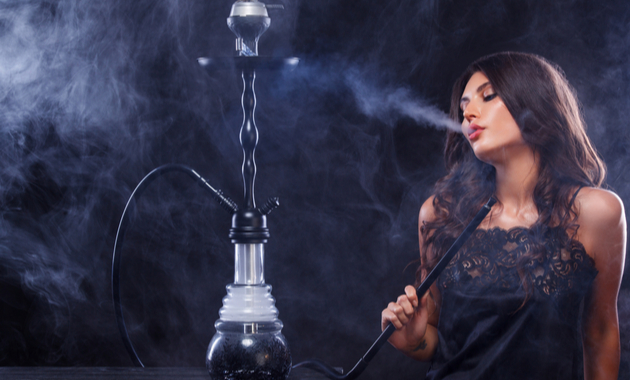
We all know that cigarette smoking is one of the biggest public health threats all over the world. It kills approximately 6 million people a year, of which around 73% live in developing countries[1]. There are numerous studies which shed light on the impact of cigarette smoking on the heart, lungs, liver, respiratory and overall health. Although there is extensive research between carcinogens and tobacco smoking in the form of beedi, cigarette, or cigars, the research on hookah smoking is scarce. Hookah smoking is becoming increasingly popular among the youth without them being aware of its tobacco content.
Hookah is an ancient way of smoking tobacco popularized by Indian and Middle-Eastern cultures. However, a global spread in its use has been witnessed in the past 20 years. According to a 2015 study[2], the prevalence of hookah is up to 15% in India. Over the last decade, it has resurged to popularity all over the country with hookah bars opening up in all major cities. Moreover, there is an incorrect perception in the public that hookah, also known as waterpipe tobacco, is less harmful than cigarettes. So in this article, we clear the top three common misconceptions about hookah.
3 Common Misconceptions About Hookah Smoking
1. Hookah Does Not Contain Tobacco
Hookahs are in fact water pipes that are designed to smoke tobacco. So basically it is tobacco which comes in different flavours and masks the taste of tobacco. Even though the flavours mask the taste of tobacco, you are indirectly smoking tobacco. This is because a hookah comprises of a water pipe which heats the tobacco using charcoal. The filters present in the hookah filters the smoke in a bowl of water and then redirects the vapours to a rubber pipe attached to the vessel for inhalation.
The tobacco used in a hookah is mainly of three types[1] –
Muessel: It contains 30% tobacco and 70% honey or molasses along with glycerol and various flavours. It is commonly used in Kuwait population.
‘Agami: It is the unflavoured one which belongs to Persia. It contains pure, dark paste of tobacco.
Jurak: it is an intermediate form of Muessel and Agami and is commonly used in India. The different flavours that are currently available include grapes, apple, watermelon, mint, etc.
Tobacco Threatens..!! Say No To Tobacco Now. How? Let Us Help. Click Here.
2. Hookah is Less Harmful than Cigarettes
As smoking hookah is nothing but smoking tobacco, it carries the same health risks as that of smoking cigarettes. In fact, hookah smoking can be more severe than tobacco. Here are a few interesting facts you need to be aware of:
-The charcoal used to heat up a hookah/shisha produces high levels of carbon monoxide which is poisonous as it impairs the blood flow to different organs of the body.
-Tobacco smoke and toxins produced by smoking a hookah/shisha increases the risk of developing lung, bladder and oral cancer[3].
-Even though the smoke passes through water, it still contains high levels of toxic compounds such as metals, carbon monoxide, and other cancer-causing chemicals[3].
-The amount of smoke inhaled from a hookah session can be as high as 90,000ml, which is more than 100 times as compared to cigarette smoking. The amount of smoke inhaled from smoking a single cigarette is around 500 ml[4].
3. Second-hand Smoke From Hookah Is Not Dangerous
Just like second-hand smoke from cigarettes is harmful to health, secondhand smoke from a hookah is also dangerous. This is because of large amounts of smoke produced by smoking hookahs. A typical session of shisha smoking lasts for around 20 to 80 minutes which is much higher than cigarette smoking which typically takes about 5 to 8 minutes. During this time, shisha smokers can take up to 200 puffs but in contrast, cigarette smokers take around 8-12 puffs. This clearly indicates the possibility of higher levels of second-hand smoke with shisha smoking as compared to cigarette smoking[1].
The smoke released from a hookah contains many harmful chemicals such as ammonia, benzene and arsenic. Moreover, the burning of charcoal in case of hookah is also toxic to health[5]. Repetitive exposure to second-hand smoke from hookahs can cause your lungs to deteriorate at a faster rate.
**Consult India’s best doctors here**
Despite numerous reasons for not smoking hookahs, several misconceptions have lead people to think that it is safe as compared to cigarette smoking. However, this is not true as hookahs produce a lot of smoke which causes you to inhale more smoke than smoking cigarettes. A typical session of shisha smoking has about 25 cigarettes worth of tar, 11 cigarettes worth of carbon monoxide (CO), and 2 cigarettes worth of nicotine[6]. As hookah/shisha or smoking tobacco is harmful to health, the only way to reduce your risk of life-threatening diseases is to quitting smoking cigarettes as well as hookah.
(The article is reviewed by Dr. Lalit Kanodia, General Physician)
Recommended Reads:
Top 20 Smoking Myths Busted: No More Excuses To Quit Smoking!
Nicotine Gum: Your Aid To Quit Smoking
References:
1. Husain H, Al-Fadhli F, Al-Olaimi F, et al. Is Smoking Shisha Safer than Cigarettes: Comparison of Health Effects of Shisha and Cigarette Smoking among Young Adults in Kuwait. Med Princ Pract. 2016;25(2):117-22.
2. Dani KK, Oswal K, Maudgal S, Saranath D. Perception of young adults toward hookah use in Mumbai. Indian J Cancer. 2015 Oct-Dec;52(4):694-7.
3. Conference of the Parties to the WHO Framework Convention on Tobacco. Conference of the Parties to the WHO Framework Convention on Tobacco. Moscow: World Health Organization; 2014. p. 13-18.
4. CDC – Fact Sheet – Hookahs – Smoking & Tobacco Use [Internet]. Smoking and Tobacco Use. 2018 [cited 4 August 2018].
5. Smith CJ, Perfetti TA, Mullens MA, Rodgman A, Doolittle DJ. ‘IARC Group 2B Carcinogens’ reported in cigarette mainstream smoke. Food Chem. Toxicol;2000. P. 825–848.
6. Ali M, Jawad M. Health Effects of Waterpipe Tobacco Use: Getting the Public Health Message Just Right. Tob Use Insights. 2017 Apr 11;10:1179173X17696055.